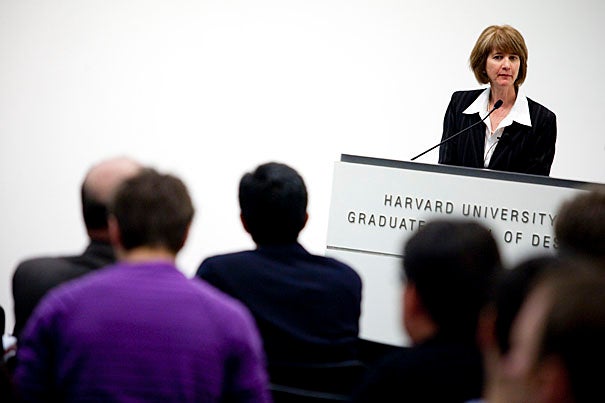
U.S. Undersecretary of Energy Kristina Johnson says the United States plans to cut its fossil fuel use from about 80 percent of the energy consumed now to just 20 percent by 2050, an ambitious undertaking that requires immediate shifts to be achieved.
Stephanie Mitchell/Harvard Staff Photographer
Ambitious undertaking
Energy official says plan would trim conventional fossil fuel use to 20 percent of energy mix by 2050
The United States plans to cut its conventional fossil fuel use from about 80 percent of the energy consumed now to just 20 percent by 2050, an ambitious undertaking that requires immediate shifts to be achieved, according to a key U.S. energy official.
Kristina Johnson, undersecretary at the U.S. Department of Energy (DOE), said an array of measures will be needed to achieve that goal, including conservation and new technologies, such as carbon capture and storage, which would make conventional fossil fuel sources cleaner. But if technology is to help solve the climate conundrum, the process of turning new discoveries into usable products has to be accelerated, since it now can take decades to go from the lab to the market, Johnson said.
Johnson spoke Tuesday (April 13) at the Graduate School of Design’s Gund Hall as part of the Harvard University Center for the Environment’s (HUCE) “Future of Energy” lecture series. Her talk, “The Role of Innovation in Solving America’s Energy and Environmental Challenges,” was introduced by HUCE Director Daniel Schrag, who said Johnson is part of an “amazing cohort” of educated leaders brought into the government to deal with energy issues. Before joining the DOE, Johnson, who has a doctorate in electrical engineering from Stanford University, was provost at The Johns Hopkins University.
Johnson said the DOE’s energy goals can be summed up rather simply: Put people back to work, get them back to school, and save the planet. Turning innovation in the energy sector into jobs is important, she said, as is ensuring that students graduating from U.S. schools have the skills needed for the energy sector. Saving the planet is part and parcel of the reduction in fossil fuel use needed to fight climate change.
Johnson said that switching the transportation sector from fossil fuels is a bigger challenge than reducing such fuels in the electricity sector. The biggest challenge, however, is time. There is little of it if the world is to keep global temperature change to an average of 2 degrees Celsius above 1990 levels. Doing nothing and passing the problem on to our children would be like “rolling up the window of a car on a hot summer day with our children trapped inside.”
Americans also have competition for supremacy of the emerging clean energy industry, she said, since China is moving rapidly toward generating renewable energy, investing as much as $12.6 million on clean energy every hour.
The United States emits about 6 gigatons of carbon into the atmosphere each year. If no systemic changes are made, she said, that number will mushroom to 8 gigatons annually by 2050. The goal is to get it below 2 gigatons, she said. Energy efficiency could make a significant dent in that number, but alone could only keep it roughly at today’s level. A suite of changes, including increased use of biofuels, more nuclear power, carbon capture, sequestration technology (which keeps carbon dioxide generated by fossil fuel burning plants from the atmosphere), renewable energy sources, and other options will be needed to meet the goal.
The DOE has several programs to foster innovation in solar, wind, geothermal, and other energy sources.
The United States, she said, has a long history of world-changing innovation, from the model T car to the transistor. The DOE is working not only to foster innovation in the lab, but to speed its transition through the long process of reaching the marketplace.
“We have an urgency to invent or discover anything that possibly can help us now,” Johnson said. “We need to create a technologically savvy culture where everyone understands how we use energy.”




